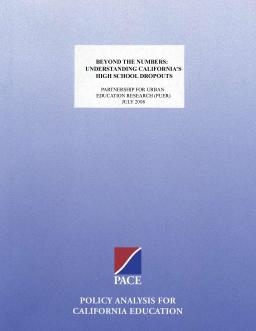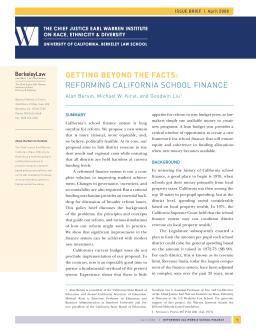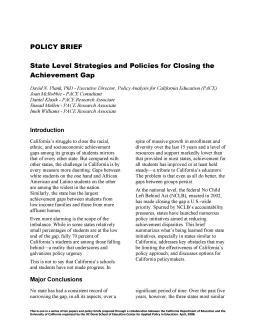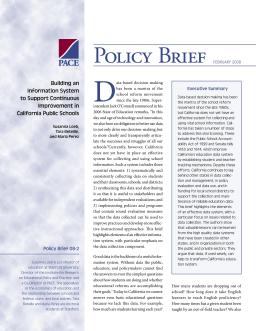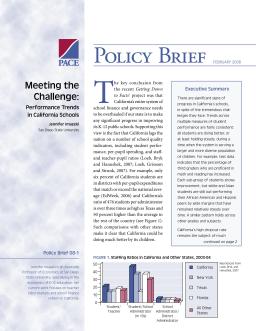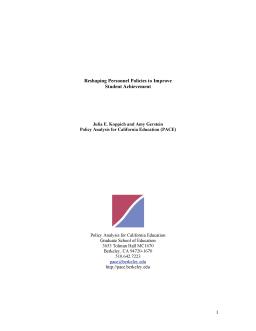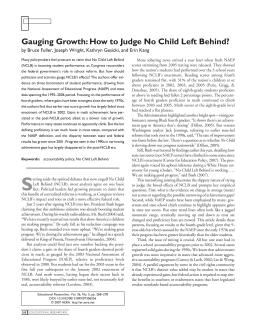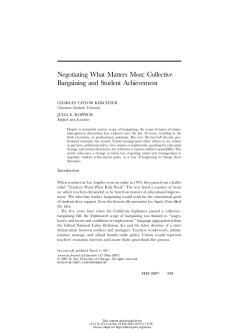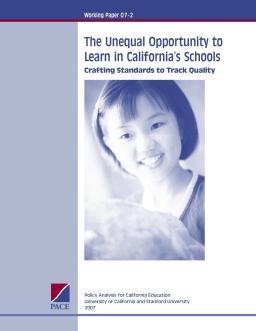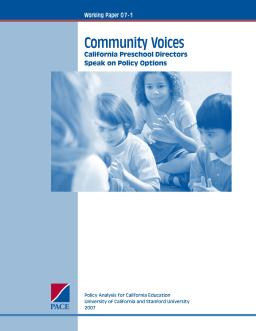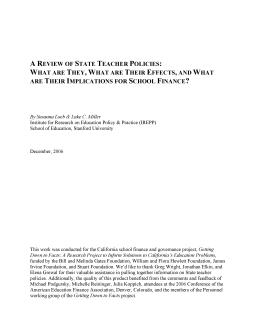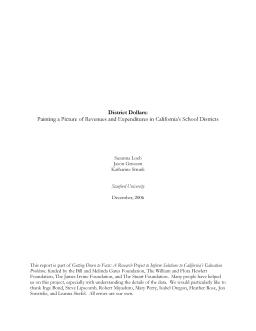School Finance and Governance in California
Published
Summary
Getting Down to Facts is an extensive investigation of CA's public education system commissioned by a bipartisan group of CA leaders. The project aimed to describe California's school finance and governance systems, identify obstacles hindering resource utilization, and estimate costs to achieve student outcome goals. The project resulted in 23 reports by scholars, which highlight that the current school finance and governance systems fail to help students achieve state performance goals, particularly those from low-income families. The reports provide a framework for assessing reform options.
The Case of California
Published
Summary
This article highlights the lack of systematic evaluations of the relationship between educational governance and student outcomes. The authors provide a framework for evaluating the effectiveness of governance systems, drawing from previous research and interviews with stakeholders in California's educational system. The aim is to guide potential policy changes and inform future studies of educational governance.
Published
Summary
PACE is bringing back its publication, Conditions of Education in California, to keep the focus on the long-term education reforms required by California. Six policy scholars have contributed to this edition, providing baseline data on school performance and recommendations for policy changes to support long-term improvement. PACE plans to continue regular publication of this report to track progress towards a more effective educational system in California.
Continuous Improvement in California’s Education System
Published
Summary
This policy brief emphasizes the need for California's education system to become a continuously improving system that fosters innovation, measures the impact of policies and practices, and learns from experience. The authors identify key features of a continuously improving system, including clear goals, reliable data, change-supportive capacity, flexible decision-making, and aligned incentives. They explain how each of these features supports continuous improvement and highlight the differences between the current education system and a continuously improving one.
Understanding California's High School Dropouts
Published
Summary
The Partnership for Urban Education Research (PUER) comprises six of California's largest urban school districts working together to increase data availability, enhance internal research capacity, and promote collaboration and information sharing across district lines to benefit students. In a new report, PUER districts identified opportunities to improve the current dropout reporting system and reviewed district efforts to reduce dropout rates. PUER is working with PACE to review and publish their research.
Reforming California School Finance
Published
Summary
This policy brief proposes a more rational and equitable school finance system for California that links district revenue to student needs and regional costs. The proposal aims to ensure that all districts are held harmless at current funding levels while providing essential backdrop for broader reform issues. The brief discusses the problems with the current finance system, the principles and concepts that guide the reform, and simulations of how it might work in practice. The report shows that significant improvement in the finance system can be achieved with modest new investment.
Published
Summary
California faces significant challenges in closing the achievement gap between different student groups, including wide disparities based on race, ethnicity, and socioeconomic status. While progress has been made, the gaps persist. This report summarizes what is being learned from state initiatives to reduce these disparities, addresses obstacles limiting effectiveness, and provides options for policymakers to address this urgent issue.
Published
Summary
This policy brief proposes policy recommendations to improve teaching quality in California schools by experimenting with new policies in professional development, evaluation, compensation, and teacher career structure. It includes descriptions of innovative programs in each area being implemented across the US. The state can play a critical role in providing incentives, evaluating effectiveness, and developing partnerships to share knowledge about effective policies and practices.
Published
Summary
California needs to improve its education data system to collect and use vital school information for continuous improvement. The state is behind in data collection, management, evaluation, and funding compared to other states. The report suggests learning from other high-quality data systems and using data to transform California's education system.
Performance Trends in California Schools
Published
Summary
California's education system faces financial and demographic challenges, with per pupil spending below the national average and a majority of students living in poverty or English Learners. However, recent state and national assessments show improved academic performance, particularly for poor and minority students. More students are taking advanced math and science courses and meeting university admission requirements. While the state falls short of its goals, systemic reforms are needed, but the gains are a result of hard work and commitment from California's educators.
The Influence of State Policy and Community
Published
Summary
Findings show that charter schools in the US perform similarly or worse than public schools due to disparities in resources. State regulation leads to fewer uncredentialed teachers, and more state spending equals more equal teacher salaries. Local context and the type of students served have the greatest impact on resource variance. Charter schools serving Black students rely on less experienced and uncredentialed teachers. Conversion charter schools pay more and have less uncredentialed and part-time teachers than start-up schools, which has implications for unequal student achievement.
Data Systems and Policy Learning
Published
Summary
This report advocates for a continuous improvement approach to education in California, emphasizing the need for a comprehensive data system to inform decision-making and evaluation at all levels of the education system. It also recommends the use of research-based practices and the development of partnerships between schools and community organizations to support student success. The report emphasizes the importance of equity and suggests strategies for addressing achievement gaps and providing more resources to under-resourced schools.
Published
Summary
This report examines personnel policies in California schools and their impact on teacher quality and student outcomes. It finds that many districts have ineffective policies and recommends reforms, such as performance evaluations and professional development. The report also emphasizes the need to attract and retain high-quality teachers, provide support for them, and promote collaboration between districts and unions.
How the First Semester Matters for Community College Students’ Aspirations and Persistence
Published
Summary
This policy brief argues that expanding access to community college alone will not prepare California's workforce for the 21st century. It shows that many high school graduates who enter community college with the goal of transferring to four-year colleges do not make it through their first semester with their goals intact. Providing additional guidance and support during the first semester could improve student persistence and transfer rates, as the first semester is crucial in shaping students' post-secondary academic careers.
Preschool and K–12 Finance Reform in New Jersey and Texas
Published
Summary
This report examines factors that affect student achievement in California schools, finding that family background and school context are important determinants. The report recommends that schools focus on providing high-quality instruction, improving reading and math skills, and creating a positive school climate. Policymakers should increase resources for under-resourced schools and promote parental involvement. Continued research is needed to better understand the complex factors that shape student outcomes.
How to Judge No Child Left Behind?
Published
Summary
This report analyzes the effects of No Child Left Behind (NCLB) on student performance using three barometers: the National Assessment of Educational Progress (NAEP), state data, and fourth-grade test scores. The authors find that earlier test score growth has largely faded since NCLB's enactment in 2002, and progress made in narrowing achievement gaps in the 1990s has largely disappeared in the post-NCLB era. The report suggests that policymakers need to reconsider the efficacy of NCLB and consider alternative approaches to school reform.
Collective Bargaining and Student Achievement
Published
Summary
This article discusses the evolution of union-management discussions in education over the past two decades, and the emergence of professional unionism. However, in recent years, professional unionism has declined due to management's reluctance to partner with unions, politicians' lack of recognition of union efforts, and unions' reluctance to take on additional responsibilities. The article recommends labor law changes that require unions and management to negotiate student achievement goals as a means of addressing these issues.
Options for California
Published
Summary
This policy brief examines accountability in California's education system, calling for a comprehensive approach that measures student outcomes and addresses systemic factors. The authors emphasize stakeholder engagement and local capacity building, and suggest a balanced approach that promotes continuous improvement for California's diverse student population.
Options for California
Published
Summary
This policy brief advocates for the expansion of career-technical education (CTE) in California's high schools through a CTE/multiple pathways approach. The authors argue that this approach integrates academic and occupational content, is more effective for students, and addresses criticisms of high schools. They propose building on existing CTE practices and providing funding, technical assistance, professional development, curriculum development, work-based learning opportunities, and data monitoring to support the expansion of CTE/multiple pathways.
Acquisition, Deployment, and Barriers
Published
Summary
This report examines the fiscal and labor resources of California principals and how they acquire and utilize them to improve student performance. The authors seek to understand the background characteristics and educational goals of California principals, as well as the types of monetary, human, and informational resources they acquire and how they allocate these resources within their schools. The report also explores the support and constraints that principals experience from various actors as they attempt to acquire and deploy resources to raise student performance.
Crafting Standards to Track Quality
Published
Summary
This paper investigates the effects of class size reduction (CSR) on student achievement in California's K-3 classrooms. Using data from the state's Standardized Testing and Reporting program, the authors find that smaller class sizes improve student achievement in English-language arts and have a stronger effect on low-income and minority students. However, the authors caution that the full benefits of CSR may be realized only with sustained implementation, quality teaching, and alignment with curriculum and instructional strategies.
California Preschool Directors Speak on Policy Options
Published
Summary
This report discusses the potential of integrating academic and occupational content through Career-Technical Education (CTE)/multiple pathways to improve California's high schools. This approach can enhance student motivation and engagement in school, improve employment and earnings after graduation, and provide more opportunities for students. They suggest building on existing practices in career academies, restructured high schools, and community colleges, but note that additional funding, technical assistance, and professional development will be necessary to support this approach.
Published
Summary
This report focuses on estimating the costs for California school districts to meet state-set achievement goals and how these costs differ across districts with different student characteristics. The study uses an econometric cost function approach to estimate base costs and marginal costs associated with poverty, English learners, and special education. The findings are compared with cost studies in other states and used to analyze whether the current school finance system appropriately accounts for cost differentials across districts.
What Are Their Effects, and What Are Their Implications for School Finance?
Published
Summary
The report explores the impact of teacher sorting, or the tendency for high-achieving students to be assigned to more effective teachers, on student achievement. It finds that teacher sorting has a significant positive effect on student achievement in both math and English language arts. The effects are particularly strong for students who start out low-achieving. The report argues that policies aimed at reducing teacher sorting, such as random assignment of students to teachers, may be counterproductive for student achievement.
Painting a Picture of Revenues and Expenditures in California’s School Districts
Published
Summary
The report explores the relationship between teacher experience, school characteristics, and student achievement. Teacher experience is positively associated with student achievement, particularly in schools with high concentrations of low-income students. Additionally, the authors find that school size, teacher turnover, and teacher qualifications also impact student achievement. The report concludes that policies aimed at improving teacher quality and experience can have positive effects on student outcomes, particularly in high-poverty schools.




